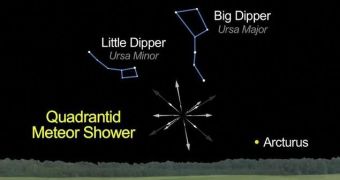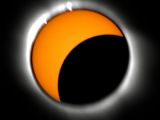This year, January 4 will be a special day, bringing skywatchers two major events: the Quadrantid meteor shower, and a partial eclipse of the sun.
Just before sunrise, you should be able to see one of the richest meteor showers of the year, followed by a partial eclipse of the sun, which will be visible only for skywatchers in Europe or parts of Africa and Western Asia.
These are the first major skywatching events of 2011, so if you're curious, you need to be prepared and warmly dressed.
The Quadrantid meteor stream gives every January, one of the most intense meteor display, with only a few hours of its sharp maximum.
Since the meteors now radiate from the northeast corner of the constellation of Bootes, the Herdsman, they could be called the 'Bootids', but back in the late-18th century there was a constellation here called Quadrans Muralis – the "Mural or Wall Quadrant".
Adolphe Quetelet of Brussels Observatory discovered the shower in the 1830's, and shortly afterward it was confirmed by several astronomers in Europe and America.
The constellation from which these meteors seem to radiate no longer exists, but in its honor, the name of the shower remained 'the Quadrantids'.
During peak activity, at least 50 to 100 meteors should be seen, but what is interesting about this phenomenon, is that six hours before and after maximum, the blue meteors appear at only a quarter of their highest rates.
This year, people living in Europe and in eastern and central Asia, should have a great show.
Around 01:00 GMT on Tuesday (January 4), the shower's activity should reach its peak, and since there will be no moonlight to interfere, the sight should be among the best of the year.
Those still awake on Tuesday morning and living in Europe, the northern half of Africa and western Asia, should benefit from a bonus – a partial eclipse of the sun, caused by the moon's penumbra scraping the northern part of the Earth.
The partial solar eclipse will first appear in Algeria, before enveloping almost all of Europe, the northern half of Africa, the Middle East, and southern Asia.
The best spot to fully enjoy the solar eclipse, will be in northeastern Sweden, along the Gulf of Bothnia, near the city of Skellefteå, at sunrise.
But if you live in another Western European city, don't worry, you should see the eclipse just fine: in London you will see 66.7% coverage at 8:12 am, local time, in Madrid, 46.8% coverage at 8:52 am local time, in Paris, 64.9% coverage at 9:09 am local time, and in Oslo, 77.9% coverage at 9:35 am local time.
One last thing, and SPACE.com's Joe Rao insists: be very careful when looking at the eclipse and make sure you only admire it through a proper light filter!

 14 DAY TRIAL //
14 DAY TRIAL // 
